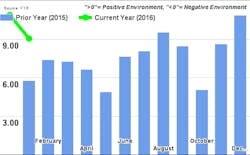FTR: January TCI reflects slow growth for truck freight
FTR’s Trucking Conditions Index (TCI) measure for January begins to reflect slowing growth patterns for trucking transportation.With a reading of 9.05, the index fell from a recent high of 10.88 in December. Current freight demand can easily be handled by current carrier capacity. However, the market will begin showing a reaction to the possible regulatory crisis coming in 2018, possibly moving the index into a double digit positive range by later this year.While FTR forecasts a modest recovery from weak January truck loadings, the rebound will be in line with modest freight growth. As the current economic recovery is extended, market conditions are slowly slipping and becoming more volatile.Details of the January TCI are found in the March issue of FTR’s Trucking Update, published March 1. The ‘Notes by the Dashboard Light’ commentary in the current issue looks at economic concerns on the horizon with possible recessionary scenarios. Along with the TCI and ‘Notes by the Dashboard Light,’ Trucking Update includes data and analysis on load volumes, the capacity environment, rates, costs, and the truck driver situation.Jonathan Starks, COO at FTR, commented, “Growth in the highly visible long-haul dry van segment has notably slowed and has actually been negative for the last year. The data that has come out of the spot market for the last year highlights those results with capacity much looser and rates down. However, the contract market has held up relatively well during that same stretch of time.“We are hearing of a much tougher negotiating environment for truckers heading into the spring freight uptick,” he added. “Headwinds to the recovery are building and 2016 is not likely to be as strong a year for truck operators. After 2016, however, the situation could begin to reverse as carriers implement ELDs and speed limiters ahead of the mandatory dates set for late 2017 and early 2018. Even if the economy sours between now and then, the impact of those regulations could be enough to keep capacity relatively tight and rates neutral.”
